
Gaining Insights into the Secret Lives of Wild Animals
By Namibian Chamber of Environment
9th August 2019
If you have had the privilege of spending plenty of time watching wildlife in Africa’s wilderness areas, it is likely that you have spotted an animal wearing a collar. In the context of a safari in the wilderness the presence of a clunky leather collar around the neck of a majestic lion or elephant may seem out of place and even jarring, as it reminds us that man’s impact on the environment extends right into the lives of individual animals. This may leave you wondering: why are collars necessary? What benefit do the animals get from humans catching and collaring them? What information do scientists get from these devices, and how is it used?
The basic reason for attaching a tracking device to an animal (not all devices are collars) is to find out where animals go and what they do across the landscape. These devices either send their location directly to the researchers’ computers via satellites, or store this information until they are retrieved and the data points are downloaded.
Although one could try to find out where animals go by following them day and night, come rain or shine, such an effort would require enormous amounts of time to gather enough information to be useful for answering scientific questions. Furthermore, the presence of a person or vehicle may interfere with the animal’s normal behaviour, for example, by disturbing hunting or mating. Some animals, like bats, fish and birds, would be impossible to follow so closely anyway. Attaching a device that can tell us where the animal goes 24/7 without our constant presence is therefore considered a less intrusive and more practical approach to wildlife research.
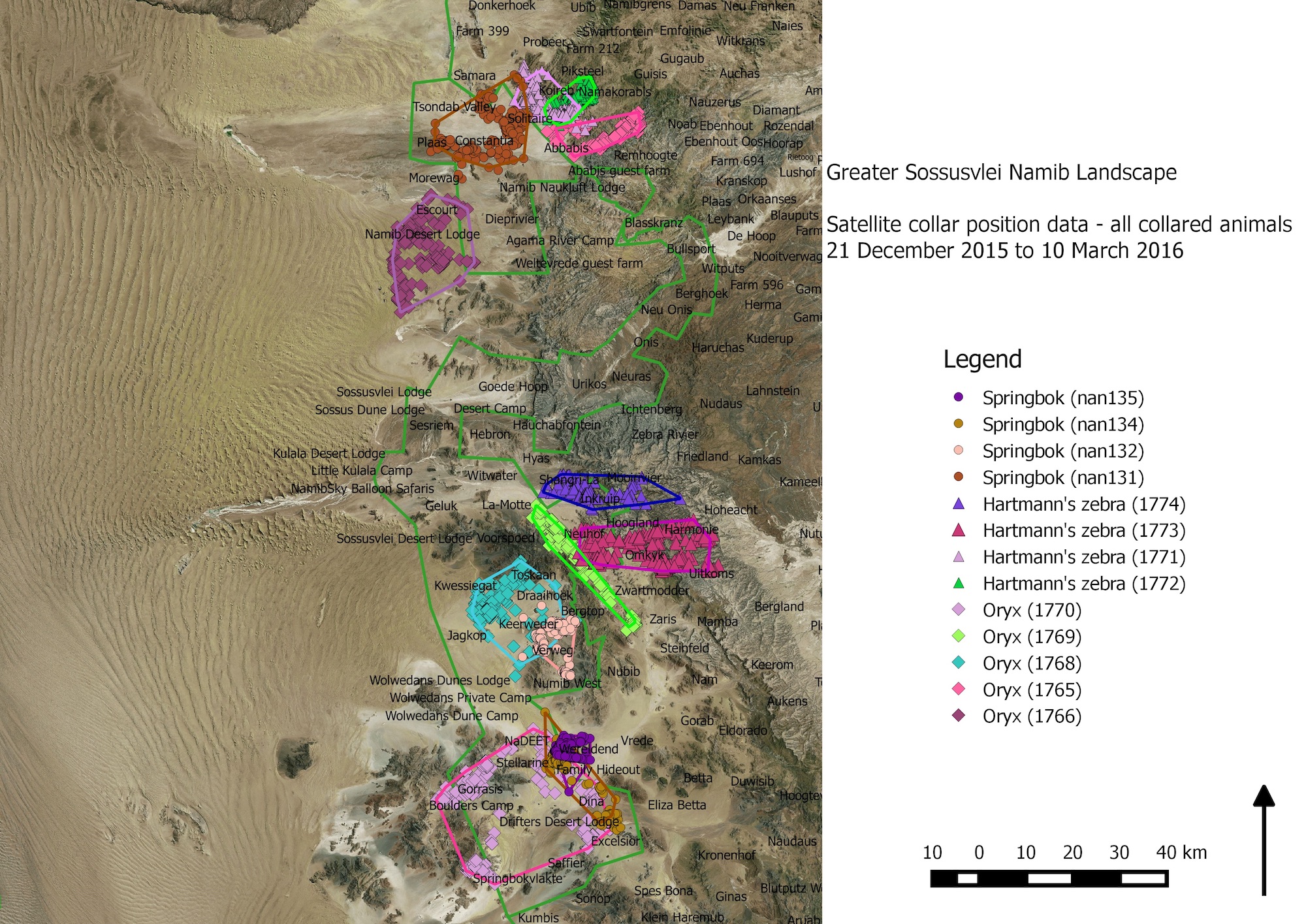
But why do we need to know where an animal goes and what it does all the time? Is it not good enough just to know that they are out there living their lives? In an ideal world, the only reason for tracking animals would be for purely scientific purposes, to find out more about their behaviour and ecology. In reality, animals are under threat, and tracking them has become essential to conservation efforts. In Namibia, the Ministry of Environment and Tourism (MET) recognises the value of data gained through wildlife tracking, but also acknowledges that more needs to be done to use this information for conservation management.
With this in mind, MET organised a wildlife tracking symposium in November 2016, with funding from B2Gold and in partnership with Namibia University of Science and Technology (NUST) and the Namibian Chamber of Environment. The Deputy Director of Research and Monitoring, Kenneth /Uiseb, emphasised the importance of wildlife tracking as a conservation tool, especially as man-made environmental threats – from destroying local habitats to changing the global climate – continue to force animals to change their behaviour and movement patterns, often leading to conflict with people. He welcomed the 38 delegates to the symposium – many of whom have used tracking devices for a diverse array of species, from puff adders to elephants, to answer a variety of research questions.
This overview of the symposium will give you a glimpse of the kinds of data that researchers gather with tracking devices, and how this information can ultimately be used for the benefit of the animals being tracked.
Reducing Human-Wildlife Conflict
One of the clearest links between tracking animals and conserving them is the potential for reducing human-wildlife conflict. Representatives from N/a’an ku sê, Africat, the Cheetah Conservation Fund (CCF) and the Leibniz Institute for Zoo and Wildlife Research (IZW) showed how collaring leopards, lions and cheetahs could help reduce conflict incidents and change farmers’ attitudes towards these predators.
Using GPS collars that show lion movement in near real-time, the team at Africat warns communal farmers living on the western boundary of Etosha when the collared lions are in their area. Specially trained ‘lion guardians’ are alerted to the presence of lions, and they ensure that cattle are herded and put into predator-proof kraals each night until the threat has subsided.
Meanwhile, N/a’an ku sê, CCF and IZW have collared leopards and cheetahs on commercial farms, revealing that many cats which were previously viewed as ‘problem animals’ were actually not responsible for livestock losses. Sharing tracking information with farmers who live with these carnivores thus has an important role to play for ensuring the long-term survival of these species outside protected areas (read more about IZW’s work here).

In cases where leopards and cheetahs have to be removed from farms due to conflict, tracking collars can help determine whether relocations to new areas are successful. In particular we need to know if the animal settles in the new area or tries to return, and whether or not it starts killing livestock again after being relocated. N/a’an ku sê reported that 67% of the leopards and 57% of the cheetahs they relocated survived for at least a year afterwards. Similarly, CCF reported a 68% success rate for the cheetahs they returned to the wild after being kept in captivity for some time.
According to the IZW, the likelihood of whether a male cheetah stays in the new area or returns to where it was caught might depend on whether he was holding a territory or not. A territorial male is more likely to return, whereas one without a territory might stay in the new area. Nonetheless, all of these organisations recognise the importance of keeping cheetahs and leopards in their original home ranges on farmlands in Namibia, which can only be done by working alongside farmers as conservation partners.
Presentations from the Kwando Carnivore Project, the University of Namibia (UNAM) and the University of KwaZulu Natal (UKZN) confirmed that knowledge about animal movements contributes indirectly to addressing human-wildlife conflict. The UKZN study reveals how killing lions on farms on the southern boundary of Etosha could influence the lion populations inside the park. Although the Etosha lion population is healthy and big enough to survive despite conflict, the UNAM/MET study in the Zambezi Region shows that the lion population in Mudumu National Park is severely threatened by the same problem. Similarly, spotted hyenas require a much larger area than is available within the small national parks in eastern Zambezi, according to tracking data collected by the Kwando Carnivore Project. Together, these studies underline a pressing need for protected areas to engage proactively with neighbouring communities to reduce human-lion conflict.
Besides carnivores, elephants and snakes were highlighted as species affected by human-wildlife conflict. N/a’an ku sê has partnered with NUST to study puff adders that are relocated away from their research and visitors centre. The data show that the relocation of puff adders has a high success rate, and that the snakes do not usually return to where they were caught. On a very different scale N/a’an ku sê has partnered with MET to track elephants in conflict areas in northern Namibia as part of an early warning system to help prevent conflicts with farmers (read more about it here).
Understanding Transboundary Animal Movements
The Kavango-Zambezi Transfrontier Conservation Area (KAZA) has turned several researchers’ attention to tracking animals that cross the borders of the countries involved in the KAZA initiative, i.e. Namibia, Angola, Botswana, Zambia and Zimbabwe. MET researchers have found that buffaloes, elephants, crocodiles and other large carnivores all move through the Zambezi Region of Namibia en route to or from the other KAZA countries.
A UNAM and MET study of African wild dogs further confirmed the key importance of the Zambezi Region. Several dog packs were collared in the Zambezi, which revealed that their home ranges reach into Botswana, Zambia and Angola. Additionally, the UNAM and MET studies indicated that animals from Khaudum National Park and neighbouring conservancies in the Kavango East Region move far into north-western Botswana.
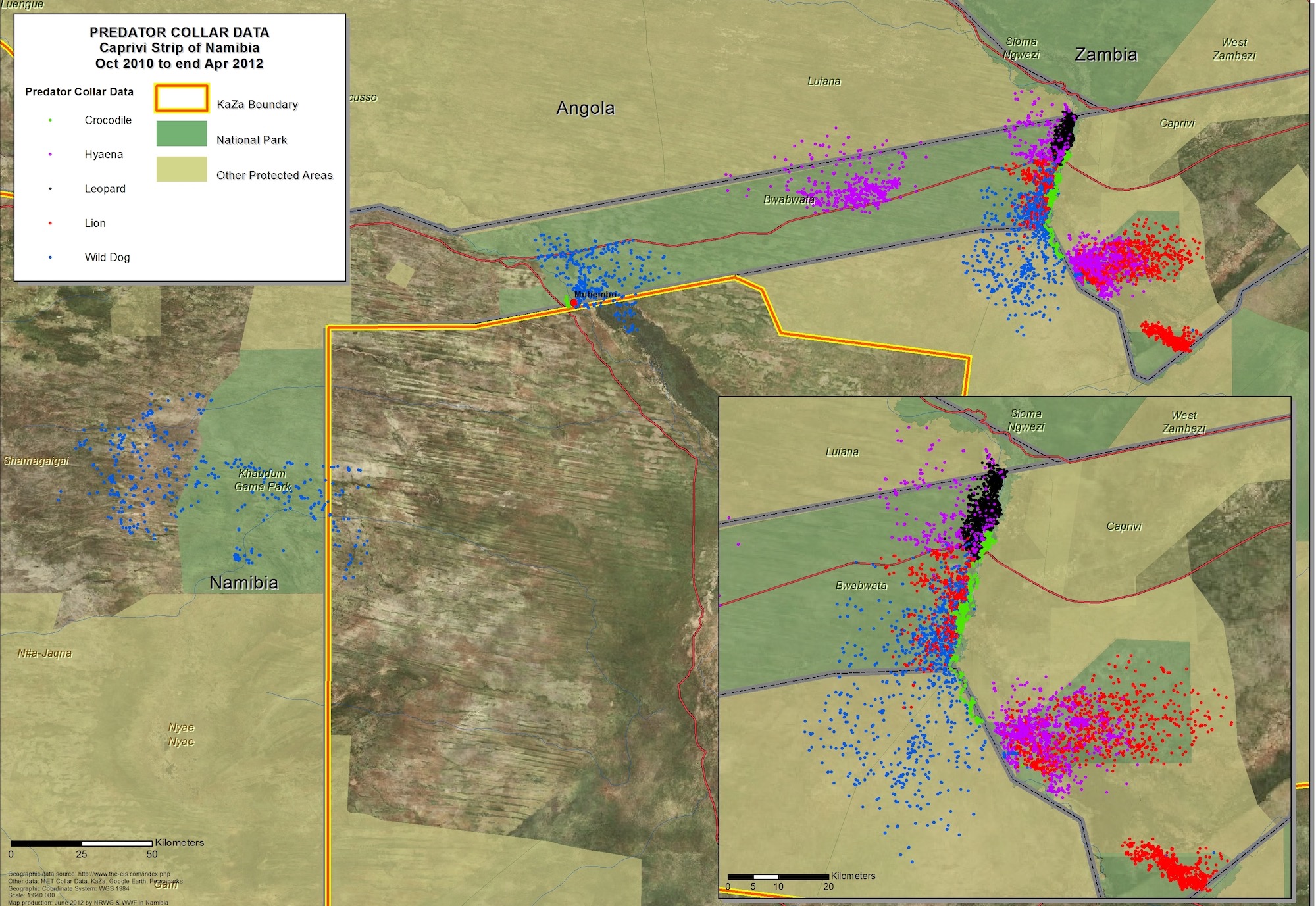
The Zambezi Region is thus a critical corridor within KAZA, which hosts globally important populations of lions, elephants and wild dogs, to name but a few. The chief value of these tracking studies is to find out which areas in KAZA function as key corridors for different species. In all five countries the areas demarcated in KAZA include fully protected national parks, multiple use areas like communal conservancies and farmlands with no conservation status. When overlaid with the boundaries of protected areas and conservancies, animal movement data can indicate which non-protected areas in KAZA need to be earmarked for future conservation action.
The most amazing international journeys recorded through tracking devices thus far come from bird studies. Although we know that some birds migrate seasonally across continents and even oceans, researchers from Raptors Botswana did not expect their Lappet-faced Vultures to take several round trips of over 1,000 km to Namibia! The vultures collared during this project breed in Botswana and were thought to stay relatively close to their breeding sites. Yet tracking information reveals that they fly from the Central Kalahari Game Reserve in Botswana to the //Karas and Hardap regions in southern Namibia and back again, for entirely unknown reasons.
The delegate from VulPro in South Africa presented similarly astonishing flying achievements by a Cape Vulture and a White-backed Vulture that were released at the VulPro centre in Gauteng, yet flew through Botswana and into Namibia. The Cape Vulture also visited southern Angola, Zambia, Zimbabwe and Mozambique on its epic southern African journey. The Rare and Endangered Species Trust (REST) from Namibia highlighted the current vulture crisis with their presentation at the symposium. The pressing conservation concerns and impressive long-distance journeys underlined the need for collaboration among vulture conservationists throughout southern Africa.
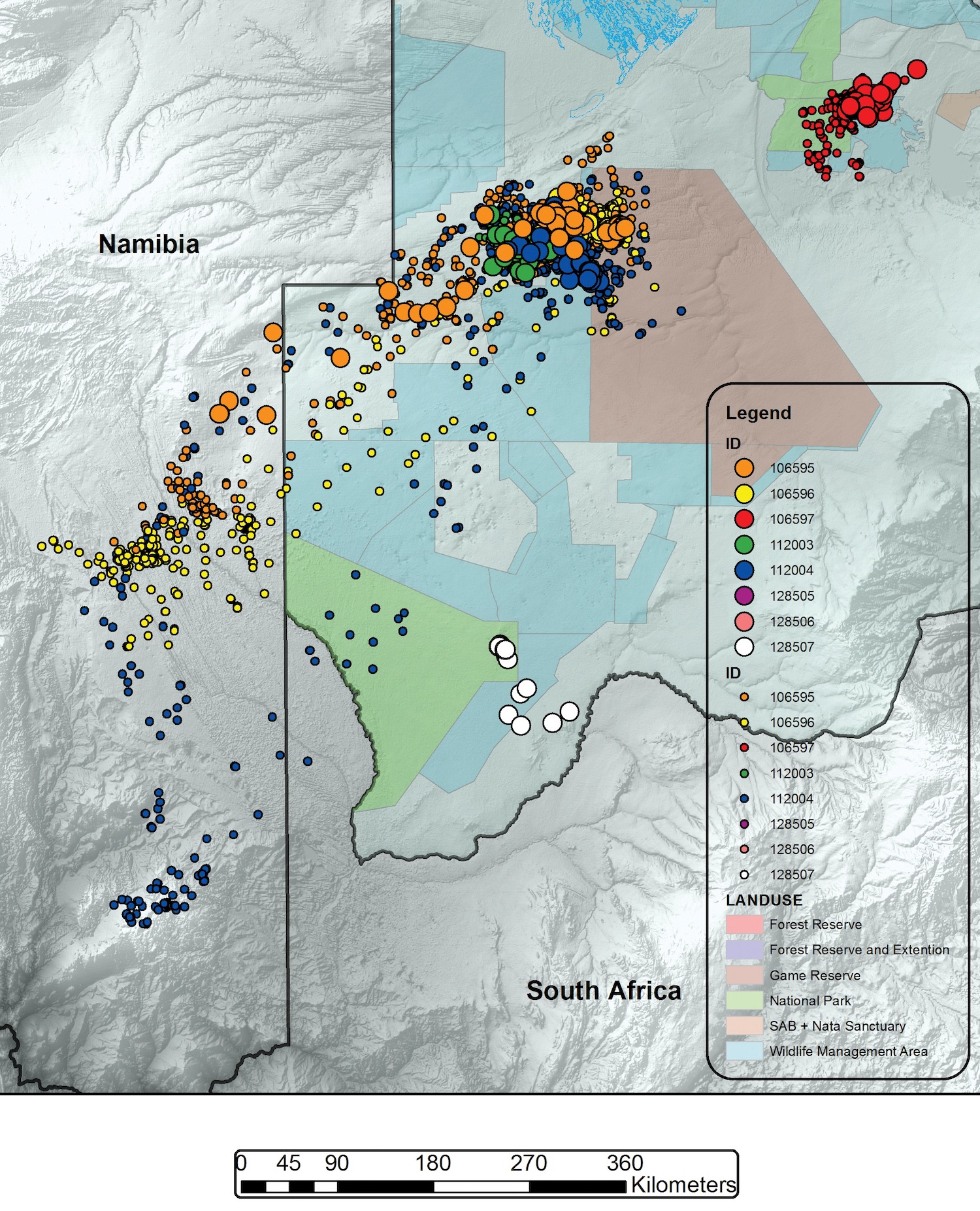
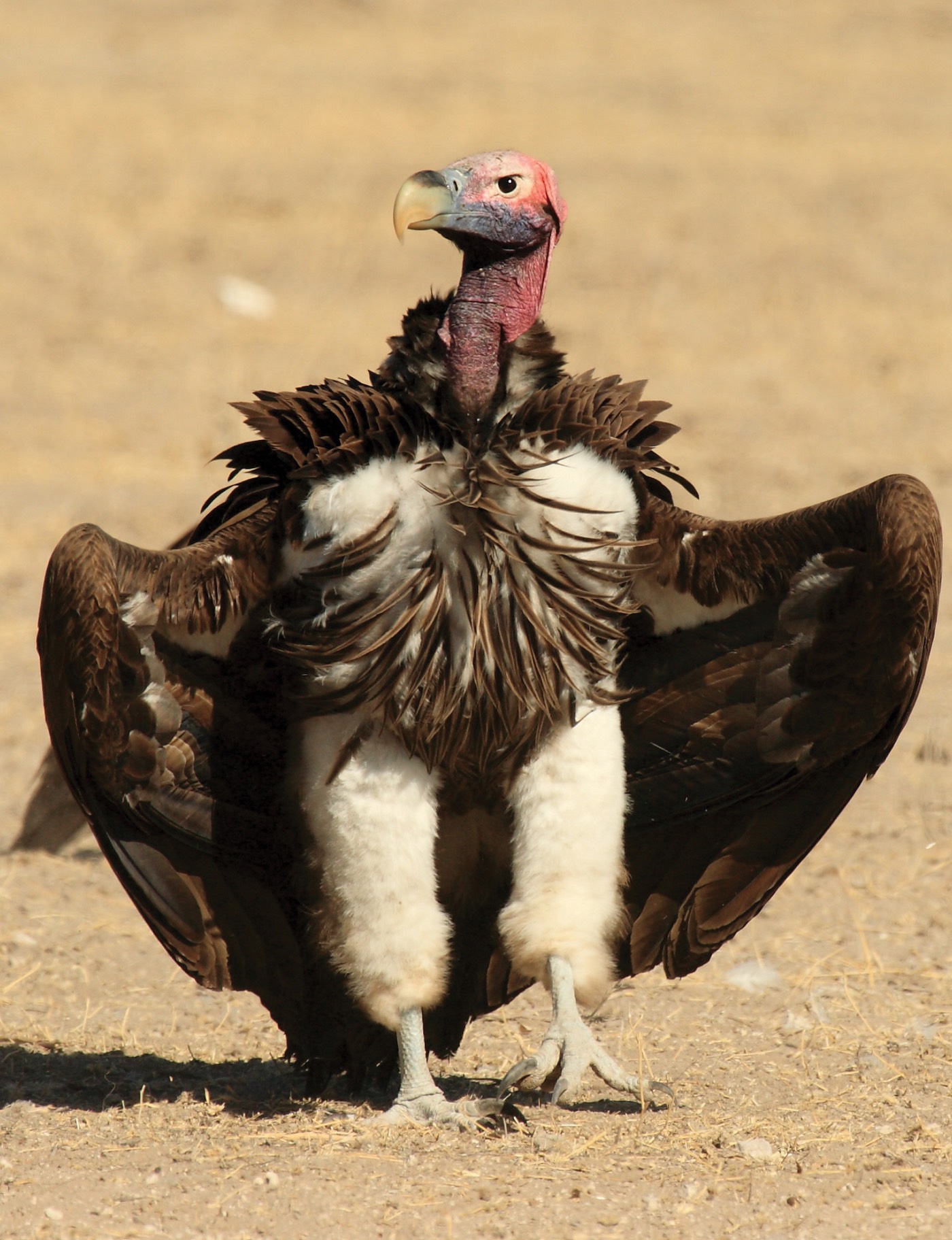
Using Animal Movements to inform Conservation Management
All animals need to find enough food to survive and reproduce to pass their genes on to the next generation. Consequently, studies that focus on where animals go to find food and when and where they give birth are vital to understanding how we can conserve them.
MET’s researchers in the Kavango and Zambezi regions have used tracking devices to find out when and where animals have their young, with particular focus on species of conservation concern like African wild dog, roan antelope, black rhino and lion. The Brown Hyena Research Project is doing similar work near Lüderitz, where they use tracking data to find hyena dens. They then set up camera traps at the den sites to unobtrusively study behaviour and record cub development. One of the key aims of the project is to ensure that the mining activities near Lüderitz do not negatively affect the hyenas, and the researchers work closely with the mining sector to achieve this goal.
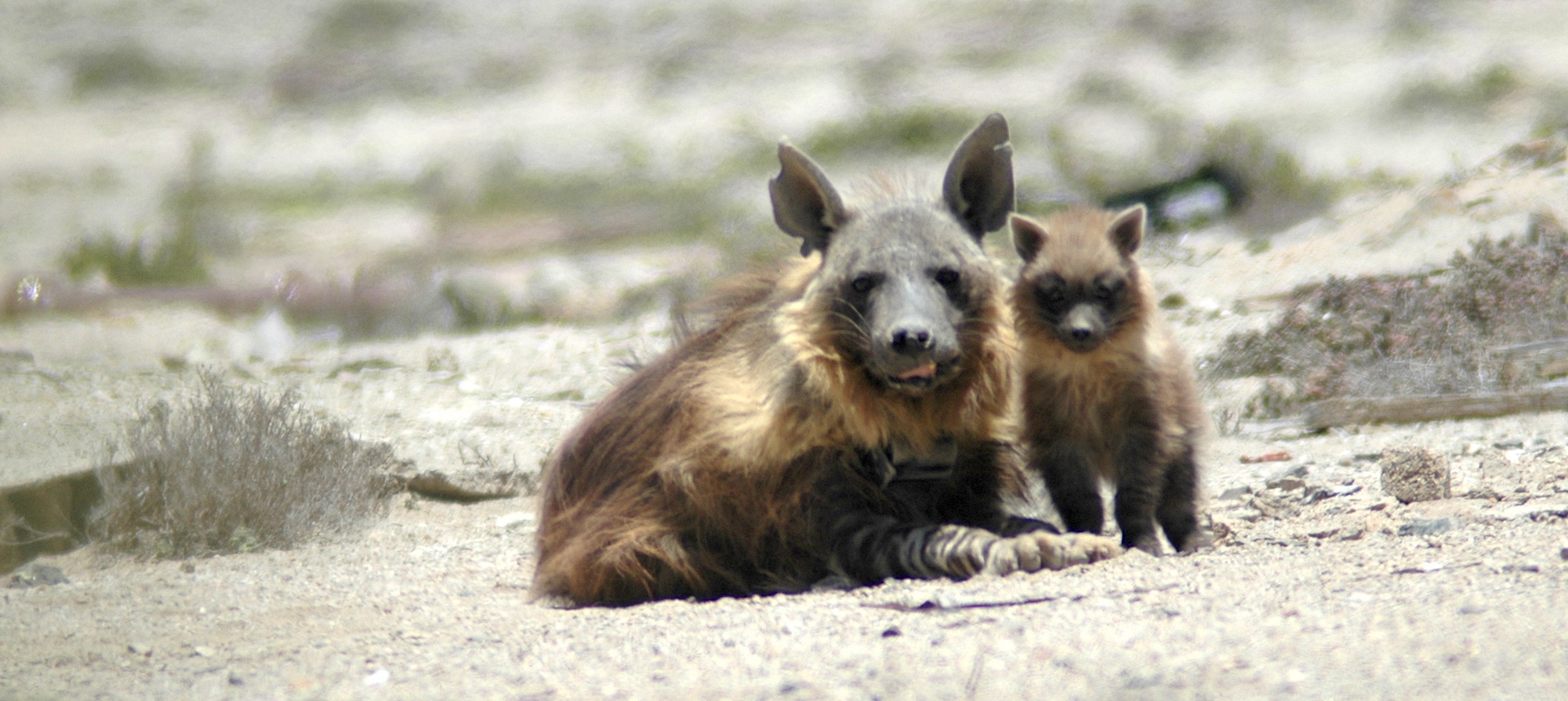
Studies in and around Etosha by MET, Africat and other researchers show that elephants, lions and Blue Cranes leave the boundaries of the park in search of food or mates. In the case of elephants and lions, young males are the most likely to move away from their herd or pride to find a new group and thus have opportunities to mate. If they leave the park on their journeys they are likely to encounter people, which may lead to conflict.
By contrast, Blue Cranes do not conflict with people, yet are critically endangered in Namibia. The national Blue Crane population has declined from over 100 in the 1970s, to only 23 counted in 2016. The Crane Working Group of Namibia tracked some of these birds, showing that they leave Etosha to visit a lake in the Oshana region to the north of the park during the dry season. Understanding what resources cranes need and why they leave the park will help manage this highly threatened population.
The need to find new food sources causes several herbivore species to migrate long distances each season to maintain their body condition. An eye-opening study by an international research team, including MET researchers, revealed the longest zebra migration in Africa, extending from the southern edge of eastern Zambezi in Namibia to Nxai Pan in central Botswana (read more about it here).
Similarly, NUST, MET and the Greater Sossusvlei Namib Landscape found that springbok, gemsbok and Hartmann’s mountain zebra in southern Namibia all migrate seasonally between farmlands, the private NamibRand Nature Reserve and the edge of Namib-Naukluft National Park (see first map of this article). These important migrations may be blocked by fencing and other human activities, which emphasises the need to identify migration routes with the help of tracking data and share this information with national development planners.
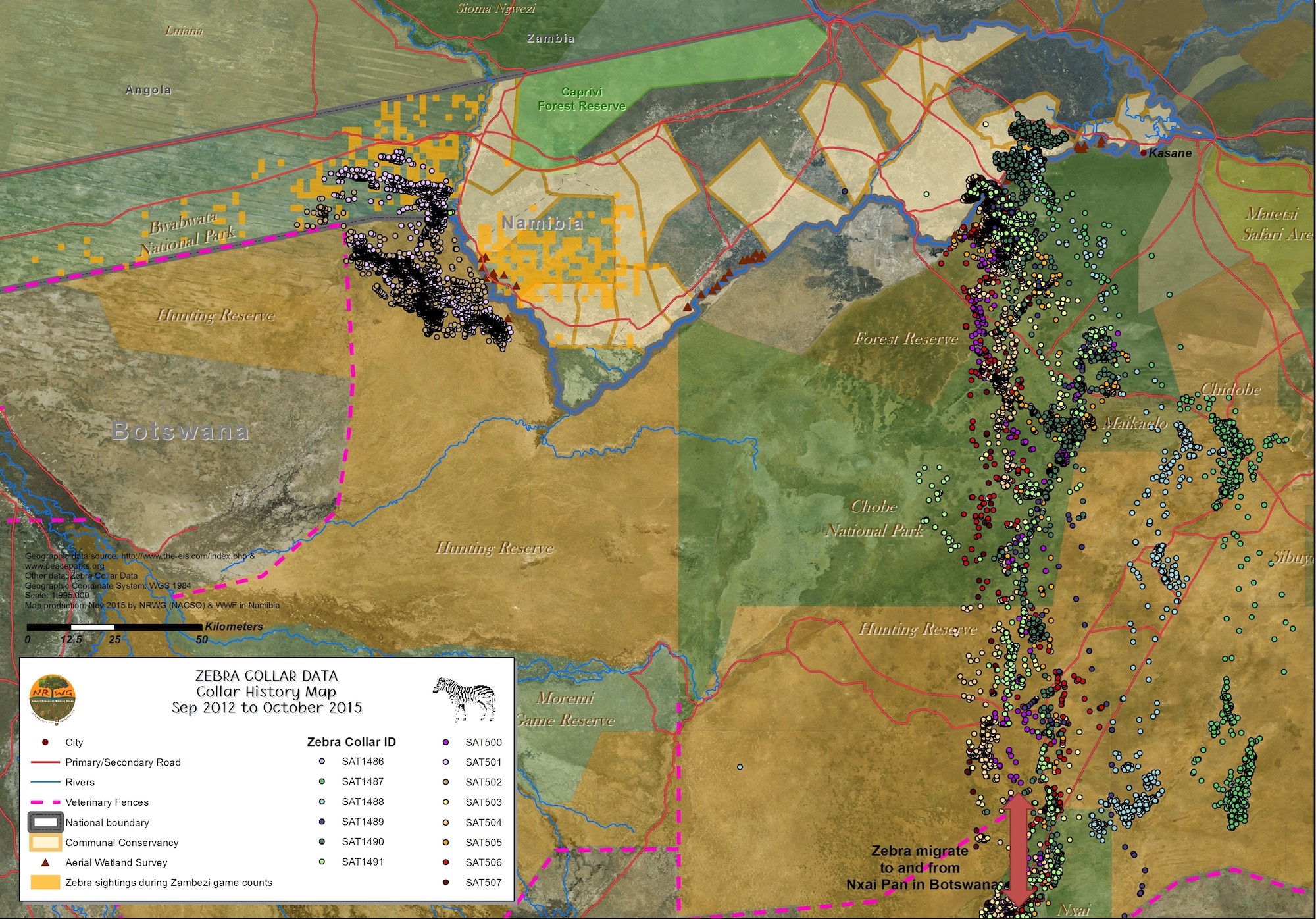
Travelling long distances to find food is by no means restricted to terrestrial animals. Seabirds that breed on the coast of Namibia must travel to and from fishing waters to feed their chicks. The African Penguin Conservation Project and their research partners sought to find out where African Penguins, Cape Gannets and Bank Cormorants go in search of fish. One of the key conservation threats to all three species is overfishing, which makes it difficult for the birds to find enough fish to feed their young. The data collected with tracking devices was used to help with the planning of a suitable Marine Protected Area off the coast of Namibia. The proposed area will protect local fish stocks and thus contribute to conserving threatened seabirds.
Moving beyond wildlife: domestic animals also require basic food resources to survive and reproduce, thus supporting rural human communities. In Namibia livestock farming is marginal, especially in the arid western regions, and according to climate change projections these regions will become even drier. A researcher from the Gobabeb Research and Training Centre, on the edge of the Namib Desert, tracked livestock movements to show how domestic animals survive in this arid landscape. By identifying key resources and linking livestock movements to rainfall patterns, this research could help livestock farming communities adapt to climate change.
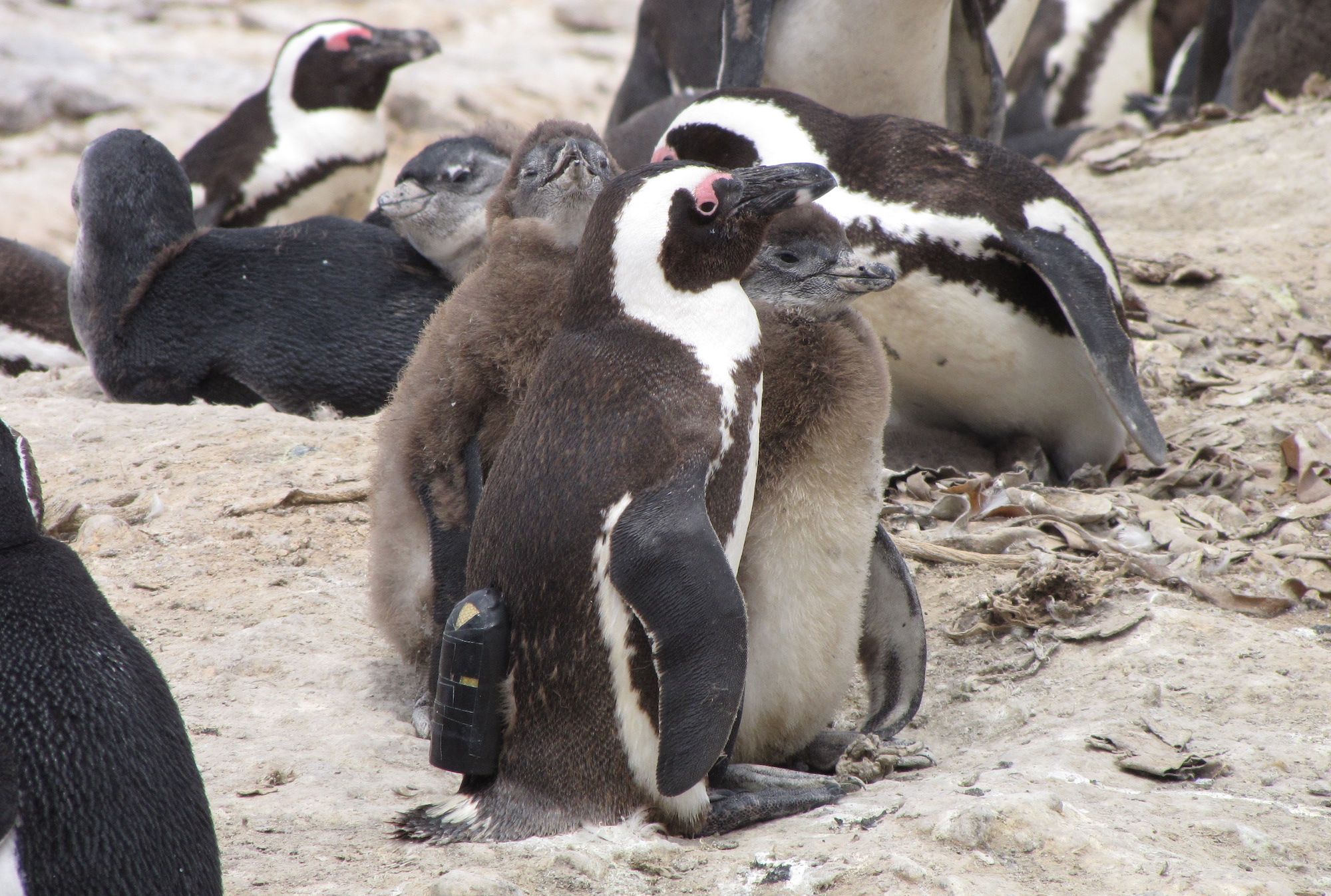
Future Plans for Wildlife Tracking in Namibia
Collaboration among researchers who track wildlife movements is key to achieving bigger conservation goals than individual research projects could achieve on their own. The symposium attendees therefore committed to staying in touch after the symposium and contributing to discussion groups that foster collaborative research, guide ethics requirements for the process of capturing and tracking animals, and support students starting new tracking projects to ensure that these studies will contribute to scientific knowledge.
The attendees recognised the need to share data and knowledge within the Namibian scientific community, and to find ways to present this information to stakeholders, decision-makers and the general public. Those working on vultures in Namibia, Botswana and South Africa agreed to work more closely together, especially considering the international journeys taken by vultures and the enormous conservation challenges facing them. The carnivore researchers agreed to use their combined knowledge to assess the conservation status of carnivores in Namibia for the IUCN Red List database (read more about it here).
As wildlife tracking technology improves, scientists will be able to peer deeper and deeper into the secret lives of their study species. Nonetheless, detailed information alone will not conserve species but can only be used to guide conservation actions. In Namibia, MET remains committed to facilitating and conducting wildlife tracking research in partnerships with non-governmental organisations and universities, to chart the way forward for wildlife conservation.
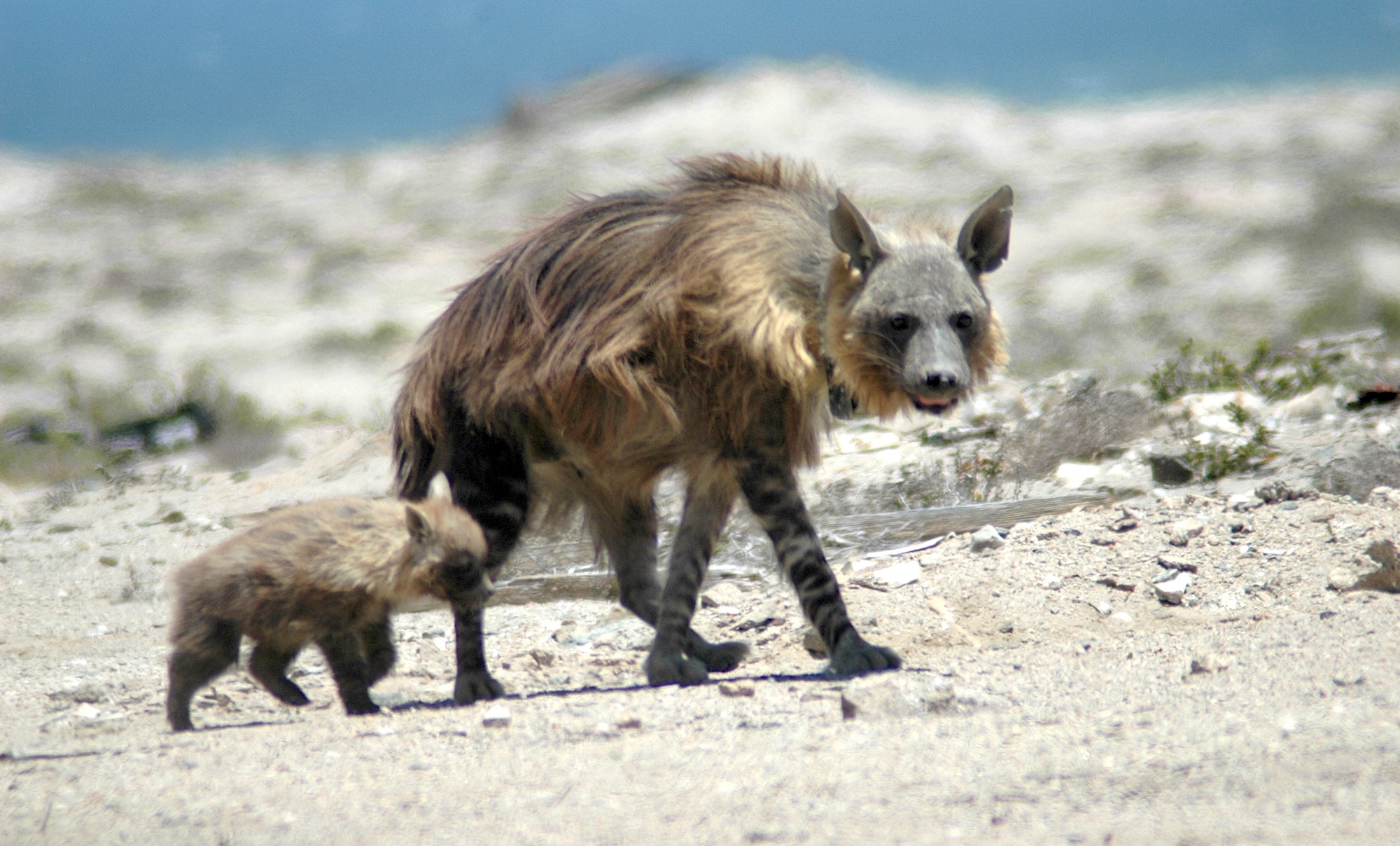
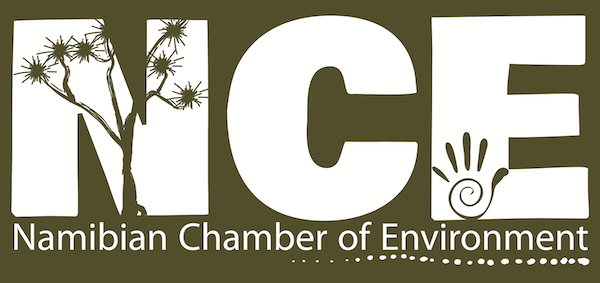
For more information about the
Namibian Chamber of Environment
visit:
www.n-c-e.org
For more information about the
Namibian Chamber of Environment
visit:
www.n-c-e.org
For articles on similar topics, please click one of the following options:
If you enjoyed this page, then you might also like:

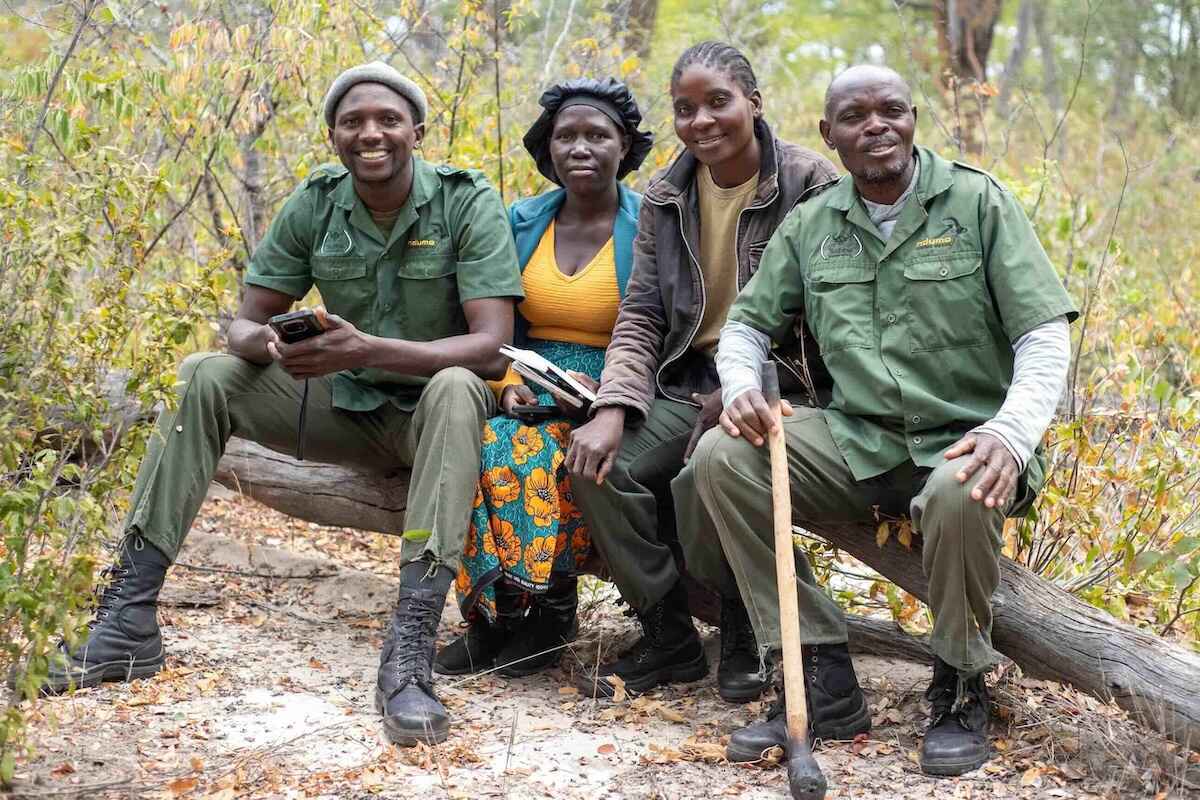
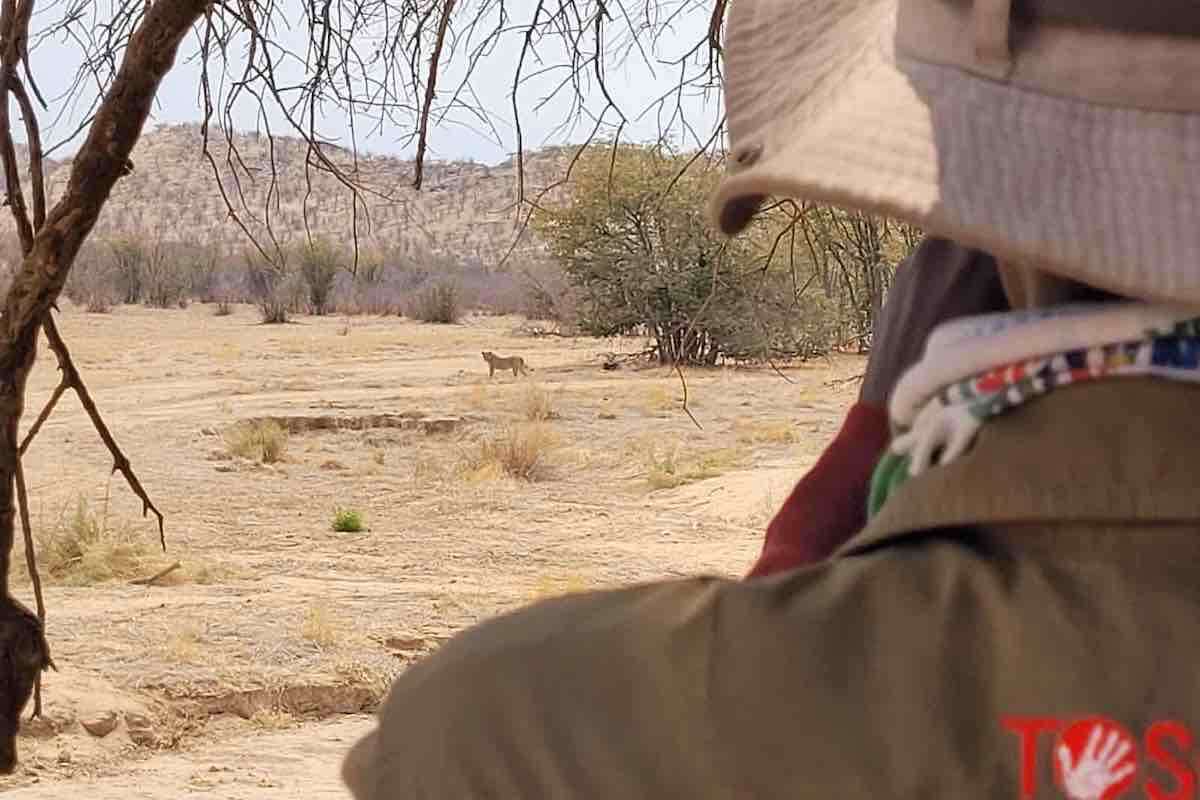
For more great articles from Conservation Namibia see below...
Conservation Namibia brought to you by:
We use cookies to monitor site usage and to help improve it. See our Privacy Policy for details. By continuing to use the site, you acknowledge acceptance of our policy.









